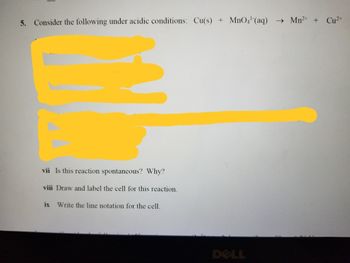
Chemistry
10th Edition
ISBN: 9781305957404
Author: Steven S. Zumdahl, Susan A. Zumdahl, Donald J. DeCoste
Publisher: Cengage Learning
expand_more
expand_more
format_list_bulleted
Question
thumb_up100%

Transcribed Image Text:5. Consider the following under acidic conditions: Cu(s) + MnO4¹-(aq) → Mn²+ + Cu²+
vii Is this reaction spontaneous? Why?
viii Draw and label the cell for this reaction.
ix Write the line notation for the cell.
Expert Solution
This question has been solved!
Explore an expertly crafted, step-by-step solution for a thorough understanding of key concepts.
Step by stepSolved in 3 steps with 3 images

Knowledge Booster
Learn more about
Need a deep-dive on the concept behind this application? Look no further. Learn more about this topic, chemistry and related others by exploring similar questions and additional content below.Similar questions
- Write the cell notation based on the description of the following information: Iron (III) ions are reduced to iron (II) ions in the presence of platinum electrode, and tin is oxidized to tin (II) under standard conditions.arrow_forward13.76 Round your answers to 6 decimal placesarrow_forwardDuring operation, which half‑reaction occurs at the cathode in each type of cell? In a battery (voltaic or galvanic cell) oxidation occurs at the cathode. reduction occurs at the cathode. In an electrolytic cell reduction occurs at the cathode. oxidation occurs at the cathode.arrow_forward
- A concentration cell is based on the aqueous reaction Cu²"(1.00 M) → Cu²*(0.0100 M) The cell consists of copper electrodes dipping into solutions of Cu²* ions. The anions present are sulfate ions. Write 2. the shorthand cell notation for this cell.arrow_forwardHow is the amount of current flowing through an electrolytic cell related to the amount of product produced in the redox reaction? Match the items in the left column to the appropriate blanks in the sentences on the right. multiplied coulombs Avogadro's 1 mol Faraday's 1g ampers 6.022 x 10¹ mol volts divided The number of moles of electrons that have flowed in a given electrolysis cell can be determined by measuring the total charge that has flowed through the cell. If the amount of current flowing through the cell is by the time that the current flowed, the total charge that passed through the cell in that time can be found. The relationship between charge and the number of moles of electrons constant, which corresponds to the charge in is given by of of electrons. These relationships are used to solve problems involving the stoichiometry of electrolytic cells. Reset Helparrow_forwardA chemist designs a galvanic cell that uses these two half-reactions: MnO4(aq)+8H (aq) +Se Fe³+ (aq) +e Write a balanced equation for the half-reaction that happens at the cathode. Write a balanced equation for the half-reaction that happens at the anode. half-reaction Write a balanced. equation for the Answer the following questions about this cell. 0 - Mn² (aq) + 4H₂O(1) Fe (aq) standard reduction potential +1.51 V Ered=+0.771 V 20 "red =arrow_forward
- A layer of chromium is electroplated on an automobile bumper by passing a constant current of 40.0 A through a cell that contains Cr3+(aq). How many hours are required to deposit 151 g of chromium? Note: Electroplating is the formation of a metal by the reduction of a metal cation. Select one: a. 32.7 h b. 58.4 h c. 5.84 h d. 3.27 h e. 19.5 h f. 1.95 harrow_forward232. Subject :- Chemistryarrow_forwardWhich of the following statements is(are) true for all galvanic cells? 1. Reduction occurs at the cathode. II. The anode gains mass during discharge (note: this means operation of the cell.) III. The voltage is less than or equal to zero. O only I O only III O only II O L I, and II O Il and IIarrow_forward
- Consider an electrochemical cell constructed from the following half cells, linked by a KCl salt bridge. - a Fe electrode in 1.0 M FeCl solution - a Ni electrode in 1.0 M Ni(NO) solution When the cell is running spontaneously, which of the choices are true? a.) The nickel electrode gains mass and the nickel electrode is the cathode. b.) The nickel electrode loses mass and the nickel electrode is the cathode. c.) The iron electrode gains mass and the iron electrode is the anode. d.)The iron electrode loses mass and the iron electrode is the cathode.arrow_forwardis an electrochemical cell in which a spontaneous redox reaction takes place. Electrolytic cell O Concentration cell O Voltaic cell O Batteryarrow_forwardConsider the reaction: Fe(s) + CuSO4(aq) → FeSO4(aq) + Cu(s) What is the half-cell reaction for reduction? Multiple Choice О Fe(s) -> Fe2+(aq) + 2 e- Cu2+(aq) + 2 e-→ Cu(s) О Cu(s) → Cu2+(aq) + 2e- Fe(s) + 2 e-→ Fe2(aq)arrow_forward
arrow_back_ios
SEE MORE QUESTIONS
arrow_forward_ios
Recommended textbooks for you
 ChemistryChemistryISBN:9781305957404Author:Steven S. Zumdahl, Susan A. Zumdahl, Donald J. DeCostePublisher:Cengage Learning
ChemistryChemistryISBN:9781305957404Author:Steven S. Zumdahl, Susan A. Zumdahl, Donald J. DeCostePublisher:Cengage Learning ChemistryChemistryISBN:9781259911156Author:Raymond Chang Dr., Jason Overby ProfessorPublisher:McGraw-Hill Education
ChemistryChemistryISBN:9781259911156Author:Raymond Chang Dr., Jason Overby ProfessorPublisher:McGraw-Hill Education Principles of Instrumental AnalysisChemistryISBN:9781305577213Author:Douglas A. Skoog, F. James Holler, Stanley R. CrouchPublisher:Cengage Learning
Principles of Instrumental AnalysisChemistryISBN:9781305577213Author:Douglas A. Skoog, F. James Holler, Stanley R. CrouchPublisher:Cengage Learning Organic ChemistryChemistryISBN:9780078021558Author:Janice Gorzynski Smith Dr.Publisher:McGraw-Hill Education
Organic ChemistryChemistryISBN:9780078021558Author:Janice Gorzynski Smith Dr.Publisher:McGraw-Hill Education Chemistry: Principles and ReactionsChemistryISBN:9781305079373Author:William L. Masterton, Cecile N. HurleyPublisher:Cengage Learning
Chemistry: Principles and ReactionsChemistryISBN:9781305079373Author:William L. Masterton, Cecile N. HurleyPublisher:Cengage Learning Elementary Principles of Chemical Processes, Bind...ChemistryISBN:9781118431221Author:Richard M. Felder, Ronald W. Rousseau, Lisa G. BullardPublisher:WILEY
Elementary Principles of Chemical Processes, Bind...ChemistryISBN:9781118431221Author:Richard M. Felder, Ronald W. Rousseau, Lisa G. BullardPublisher:WILEY

Chemistry
Chemistry
ISBN:9781305957404
Author:Steven S. Zumdahl, Susan A. Zumdahl, Donald J. DeCoste
Publisher:Cengage Learning

Chemistry
Chemistry
ISBN:9781259911156
Author:Raymond Chang Dr., Jason Overby Professor
Publisher:McGraw-Hill Education

Principles of Instrumental Analysis
Chemistry
ISBN:9781305577213
Author:Douglas A. Skoog, F. James Holler, Stanley R. Crouch
Publisher:Cengage Learning

Organic Chemistry
Chemistry
ISBN:9780078021558
Author:Janice Gorzynski Smith Dr.
Publisher:McGraw-Hill Education

Chemistry: Principles and Reactions
Chemistry
ISBN:9781305079373
Author:William L. Masterton, Cecile N. Hurley
Publisher:Cengage Learning

Elementary Principles of Chemical Processes, Bind...
Chemistry
ISBN:9781118431221
Author:Richard M. Felder, Ronald W. Rousseau, Lisa G. Bullard
Publisher:WILEY